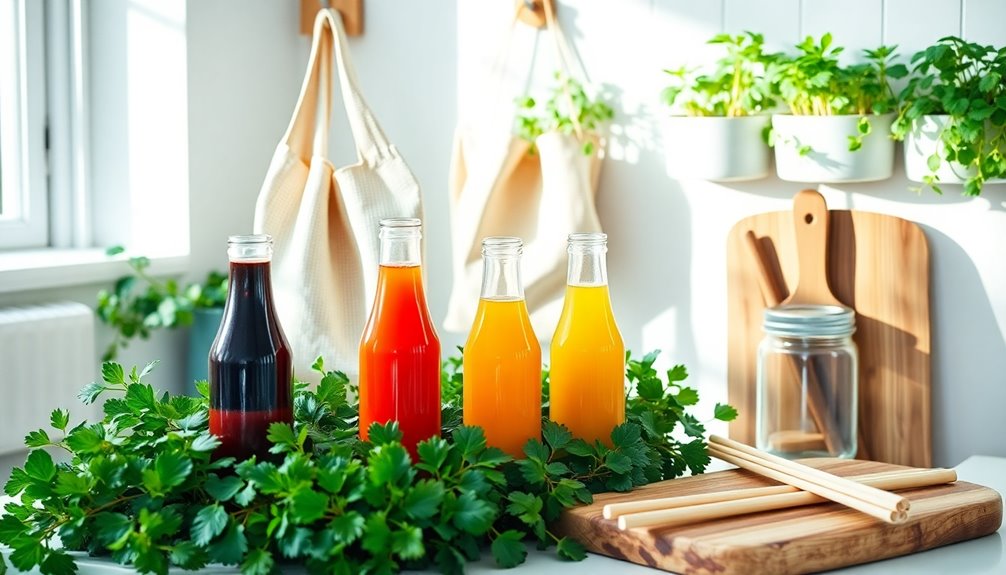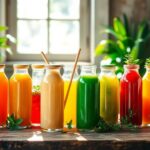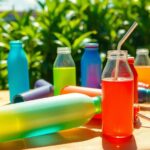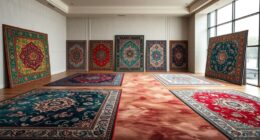To go eco-friendly with your beverage packaging and storage, start by using biodegradable materials and optimizing your packaging size to cut down on waste. Educate yourself on recycling practices and consider innovative plant-based packaging options. Encouraging creative repurposing of containers not only reduces waste but adds a touch of personality to your home. Finally, avoid unnecessary packaging in your supply chain. These steps can greatly lower your environmental impact, and there's more you can explore!
Key Takeaways
- Use biodegradable packaging materials, like plant-based polymers or bagasse, to reduce environmental impact and support a circular economy.
- Optimize packaging size to minimize waste and lower shipping costs while enhancing storage efficiency.
- Educate consumers on proper recycling practices through clear labeling and informational campaigns to boost recycling rates.
- Encourage creative repurposing of empty containers, such as turning glass bottles into vases or aluminum cans into planters.
- Implement sustainable supply chain practices that streamline packaging processes and enhance your brand's eco-friendly image.
Utilize Biodegradable and Recyclable Materials

When you choose biodegradable and recyclable materials for beverage packaging, you're making a significant impact on the environment.
Biodegradable materials, like plant-based polymers, break down naturally within 90-180 days, greatly reducing landfill waste.
By opting for recyclable materials such as aluminum and certain paper products, you support a circular economy that promotes waste reduction and minimizes energy consumption.
Studies show nearly 71% of consumers prefer eco-friendly packaging and are willing to pay more for it.
Materials like bagasse not only offer durability but also meet compostable standards. Additionally, using biodegradable materials helps reduce the overall carbon footprint associated with traditional packaging methods.
Optimize Packaging Size to Reduce Waste

Choosing biodegradable and recyclable materials is just the beginning of your journey toward sustainable beverage packaging.
To truly make an impact, you should optimize packaging size to reduce waste. Custom-sized packaging not only minimizes material waste but also aligns with consumer preferences—nearly 70% of shoppers favor brands that embrace eco-friendly practices.
Smaller packages save on shipping costs by reducing weight and volume, which helps lower your carbon footprint. Additionally, optimizing packaging size enhances storage efficiency, allowing you to maximize warehouse space. Furthermore, considering energy monitoring features can help businesses evaluate the environmental impact of their packaging operations.
Educate Consumers on Recycling Practices

How can brands effectively boost recycling rates among consumers? To educate consumers on recycling practices, brands need to prioritize clear communication.
Providing detailed labeling on packaging, including recycling symbols and proper disposal methods, helps you understand how to recycle correctly, reducing contamination in recycling streams.
Engage with you through workshops or informational campaigns that highlight the benefits of recycling, which can inspire you to adopt sustainable habits.
Additionally, incorporating QR codes on packaging that link to online resources about recycling best practices makes information easily accessible.
Studies show that when you're informed about what materials can be recycled, your recycling participation can increase by up to 50%.
Raising consumer awareness is key to promoting eco-friendly practices and creating a healthier environment. Furthermore, high-quality content that explains the recycling process can significantly enhance consumer engagement and understanding.
Explore Innovative Plant-Based Packaging Solutions

When you're looking for eco-friendly options, plant-based packaging offers exciting benefits that can help the environment.
You'll find materials like polylactic acid (PLA) and innovative solutions made from mushrooms and seaweed that aren't only biodegradable but also compostable.
Many companies are leading the way with these sustainable choices, making it easier for you to support a greener future.
Benefits of Plant-Based Packaging
As more consumers prioritize sustainability, the benefits of plant-based packaging solutions become increasingly clear. Using materials like cornstarch, sugarcane, and mushrooms, you can greatly reduce reliance on fossil fuels. These eco-friendly options often have a lower carbon footprint and are biodegradable or compostable, breaking down naturally without harmful residues. Innovations such as seaweed-based packaging further utilize marine resources, promoting a sustainable ecosystem. Plus, research indicates plant-based packaging offers comparable durability and usability to conventional options, ensuring your products remain safe and effective. With nearly 70% of consumers considering eco-friendly packaging essential, it's time to embrace this consumer shift towards sustainable packaging. Additionally, the use of renewable resources in packaging production can significantly contribute to reducing environmental impact.
| Feature | Plant-Based Packaging | Conventional Packaging |
|---|---|---|
| Made from Renewable Resources | Yes | No |
| Biodegradable | Yes | Rarely |
| Lower Carbon Footprint | Yes | No |
| Durability | Comparable | Yes |
| Utilizes Marine Resources | Yes | No |
Types of Plant-Based Materials
There's a growing array of innovative plant-based materials revolutionizing beverage packaging.
Bioplastics, made from renewable resources like cornstarch and sugarcane, offer a biodegradable alternative that markedly cuts down carbon footprints. They contribute to a closed-loop system since they can be composted, returning nutrients to the soil.
Mushroom packaging, created from mycelium, decomposes in just a few weeks, making it an excellent choice for protective packaging.
Meanwhile, seaweed-based packaging stands out as both biodegradable and edible, providing a unique solution to plastic waste.
By choosing these plant-based materials, you can help reduce reliance on fossil fuels and lower greenhouse gas emissions by up to 80% compared to traditional plastics. Additionally, embracing sustainable options can foster a sense of responsibility for the environment and promote cultural values of resilience and strength.
Embrace these sustainable options for a greener future!
Innovative Examples in Industry
Innovative plant-based packaging solutions are transforming the beverage industry, offering environmentally friendly alternatives that consumers can feel good about. These advancements not only reduce the reliance on traditional plastics but also align with the growing consumer demand for eco-conscious products. Companies are increasingly adopting sustainable juice packaging solutions that minimize environmental impact while maintaining product freshness. As a result, brands that embrace these innovative materials are not only improving their sustainability footprint but are also enhancing their market appeal among eco-aware consumers.
Here are three standout examples:
- Compostable boxes: Companies like FoodCraft use plant-based PLA (polylactic acid) for their packaging, which helps reduce plastic waste.
- Bioplastics: Derived from renewable resources like starch, these materials require fewer fossil fuels and can be designed to be biodegradable or recyclable.
- Edible packaging solutions: Imagine consuming your drink's packaging! This innovation not only minimizes waste but also enhances environmental sustainability.
Materials like bagasse, made from sugarcane fibers, showcase the industry's commitment to green alternatives. Additionally, sustainable practices in wood stove usage support eco-friendly living by reducing reliance on fossil fuels and promoting renewable resources.
These innovative plant-based packaging options are paving the way for a more sustainable future.
Encourage Repurposing of Containers

You can give new life to empty beverage containers by repurposing them in creative ways.
For instance, think about using glass bottles as stylish vases or stainless steel cans for organizing kitchen utensils.
Creative Container Uses
Beverage containers can become more than just vessels for drinks; they offer endless possibilities for creative repurposing.
By finding new uses for these items, you can reduce waste and promote an environmentally friendly lifestyle.
Here are three eco-friendly ideas:
- Glass jars: Transform them into stylish storage solutions for spices or dry goods, enhancing your kitchen decor.
- Aluminum cans: Turn them into unique planters for small herbs, providing a sustainable alternative to plastic pots.
- Empty bottles: Use them as decorative vases, saving money while creating a beautiful focal point.
Additionally, consider using foraging baskets to collect and store wild edibles, further promoting sustainability and creativity in your home.
Embracing these creative uses not only declutters your space but also encourages recycling and a reusable mindset, making your home more eco-friendly.
DIY Storage Solutions
While many people toss their empty containers without a second thought, repurposing them into DIY storage solutions can be both practical and rewarding. By reusing recyclable containers, you can reduce waste and contribute to a sustainable lifestyle. Here are some creative solutions for your DIY projects:
| Container Type | Repurposing Idea |
|---|---|
| Glass Jars | Airtight beverage storage |
| Old Wine Bottles | Chic water or juice dispensers |
| Cardboard Boxes | Organizers for decluttering |
Transform empty beverage cans into planters or decorative storage, and use plastic containers to create watering cans or bird feeders. Each repurposed item helps keep waste out of landfills while promoting an environmentally friendly approach. Additionally, these DIY projects can also support a healthier lifestyle by encouraging organization and reducing clutter in your home.
Avoid Unnecessary Packaging in Your Supply Chain

To create a more sustainable supply chain, companies should focus on avoiding unnecessary packaging. By eliminating unnecessary packaging, you can reduce material waste and minimize your ecological footprint, which aligns with consumer preferences for sustainability.
Here are three strategies to contemplate:
- Streamline Packaging Processes: Simplifying design can lower shipping expenses and improve handling efficiency.
- Adopt Minimalistic Approaches: Embrace eco-friendly packaging that conserves resources while ensuring compliance with environmental regulations.
- Enhance Customer Satisfaction: Show your commitment to sustainable practices, as consumers increasingly favor brands with a responsible brand image. Additionally, working with top online reputation companies can help enhance your brand's credibility in promoting these sustainable practices.
Frequently Asked Questions
What Are the Eco-Friendly Packaging Methods?
When considering eco-friendly packaging methods, you've got several options.
Biodegradable materials break down naturally, reducing waste. You can also choose recycled or recyclable materials, which help create a closed-loop system.
Compostable packaging returns nutrients to the soil and supports sustainability.
Innovative solutions like mushroom and seaweed-based packaging offer sustainable alternatives to plastics.
Finally, custom-sized packaging minimizes material use, making your storage and shipping more efficient while lowering your environmental impact.
What Is the Most Eco-Friendly Drink Packaging?
When you're looking for the most eco-friendly drink packaging, aluminum cans and glass containers stand out.
Aluminum cans are highly recyclable, boasting a 69% recycling rate, and they can be reused indefinitely without losing quality.
Glass is durable and recyclable, lasting much longer than plastic.
You might also consider bioplastics or innovative materials like mushroom packaging, which are biodegradable and reduce environmental impact.
What Are the Eco-Friendly Packaging Ideas?
When considering eco-friendly packaging ideas, think about biodegradable materials like PLA bioplastics that break down naturally.
You could also explore using recycled materials, such as aluminum cans made from 100% recycled plastic.
Innovative options like mushroom packaging or plant-based materials, like bagasse from sugarcane, are great alternatives too.
Additionally, custom-sized packaging helps limit waste by using only what's necessary, making your beverage packaging more sustainable overall.
How to Create Eco-Friendly Packaging?
Imagine wrapping your products in a soft embrace of nature rather than plastic.
To create eco-friendly packaging, you'll want to choose biodegradable or compostable materials that break down easily.
Use recycled options to keep the cycle going and design custom-sized packaging to cut waste.
Educate your customers on recycling practices, and partner with sustainable manufacturers who share your commitment.
This way, you're not just packaging, but nurturing a healthier planet.
Conclusion
In a world where sustainability is the golden thread weaving through our choices, embracing eco-friendly beverage packaging is your chance to make a tangible impact. By opting for biodegradable materials and encouraging creative repurposing, you're not just reducing waste; you're cultivating a greener future. Remember, every small step you take in optimizing packaging and educating others is like planting seeds for a thriving ecosystem. Let's raise our glasses to a more sustainable tomorrow—cheers to your commitment!
Cindy thoroughly researches juicing trends, techniques, and recipes to provide readers with practical advice and inspiration. Her writing style is accessible, engaging, and designed to make complex concepts easy to understand. Cindy’s dedication to promoting the advantages of juicing shines through her work, empowering readers to make positive changes in their lives through the simple act of juicing.
















